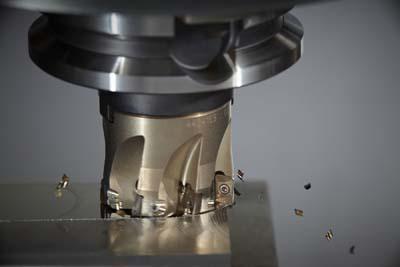
Seco Tools has released another advancement for the square shoulder milling process with its new Turbo 10 cutting tool that is suitable for most roughing, semi-finishing and finishing operations. The cutter offers improved tool life and precision by optimizing cutting properties that reduce heat generation and cutting forces.
As a highly versatile design, the Turbo 10 easily tackles slotting, contouring, helical interpolation and ramping applications with cutting diameters that range from 0.625" to 4" and a maximum cutting depth of 0.354".
The Turbo 10 employs a coated, pre-hardened cutter body with two different pitch configurations for meeting tight tolerances and providing high reliability. Mounting types for the Turbo 10 include Cylindrical, Weldon, Arbor and Combimaster.
With strong, highly positive geometries, optimized edges, a wide range of industryleading carbide grades and two different corner radii, the inserts used in conjunction with the Turbo 10 offer maximum levels of adaptability, accuracy and reliability. Furthermore, inserts can be set to a true 90°Cutting angle to create clean 90 degree walls and eliminate secondary operations. Inserts lock into place via a strong center screw placed in the same direction as cutting forces, and wiper flats optimize surface finishes.
Contact Details
Related Glossary Terms
- arbor
arbor
Shaft used for rotary support in machining applications. In grinding, the spindle for mounting the wheel; in milling and other cutting operations, the shaft for mounting the cutter.
- gang cutting ( milling)
gang cutting ( milling)
Machining with several cutters mounted on a single arbor, generally for simultaneous cutting.
- interpolation
interpolation
Process of generating a sufficient number of positioning commands for the servomotors driving the machine tool so the path of the tool closely approximates the ideal path. See CNC, computer numerical control; NC, numerical control.
- milling
milling
Machining operation in which metal or other material is removed by applying power to a rotating cutter. In vertical milling, the cutting tool is mounted vertically on the spindle. In horizontal milling, the cutting tool is mounted horizontally, either directly on the spindle or on an arbor. Horizontal milling is further broken down into conventional milling, where the cutter rotates opposite the direction of feed, or “up” into the workpiece; and climb milling, where the cutter rotates in the direction of feed, or “down” into the workpiece. Milling operations include plane or surface milling, endmilling, facemilling, angle milling, form milling and profiling.
- pitch
pitch
1. On a saw blade, the number of teeth per inch. 2. In threading, the number of threads per inch.
- slotting
slotting
Machining, normally milling, that creates slots, grooves and similar recesses in workpieces, including T-slots and dovetails.
- wiper
wiper
Metal-removing edge on the face of a cutter that travels in a plane perpendicular to the axis. It is the edge that sweeps the machined surface. The flat should be as wide as the feed per revolution of the cutter. This allows any given insert to wipe the entire workpiece surface and impart a fine surface finish at a high feed rate.

